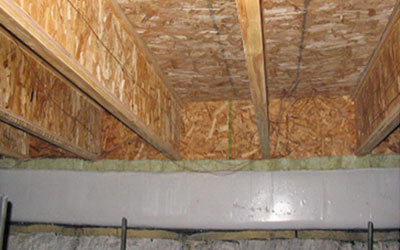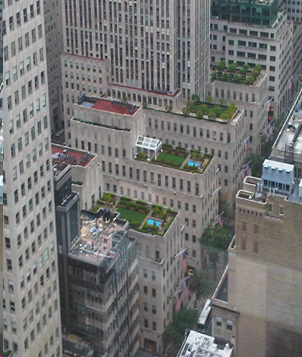Modern Construction
Fire burns faster and hotter than ever before. Learn how codes and standards can help mitigate risk to communities and fire fighters.
Research findings from Underwriters Laboratory quantify what fire fighters on the ground have observed: that modern homes and furnishings burn more quickly, flames spread more rapidly, and produce more smoke than older construction and older “legacy” furniture. Fire fighters must also be prepared for the emerging hazards associated with popular LEED-certificated “green” buildings that are designed to achieve environmental sustainability.
The best way fire fighters can mitigate these hazards is to become involved in the building and fire code processes to make sure that your local building and fire codes address the safety concerns associated with lightweight building materials, modern furnishings, and green building designs.
Lightweight Building Materials

Engineered wood is made from binding strands, particles, fibers or veneers of wood together using glues and adhesives to make particleboard, plywood, and oriented strand board. Many of the glues and resins used to bind the wood particles together are flammable, causing the material to burn faster than solid wood. The glues can also off gas noxious vapors when burned. The use of engineered wood results in an increased fuel load of a fire.

As the engineered wood trusses burn they lose mass quickly, compromising the integrity of the floor system leading to a floor collapse without warning. Studies conducted by Underwriters Laboratories found that floor systems constructed with natural wood can last up to 20 minutes in a fire before collapsing, while engineered wood floor systems last only five minutes.
Modern Home Layouts and Furnishings

Open floor plans, expansive rooms, and high vaulted ceilings are popular trends in modern home construction, but these large open spaces cause fires to spread more rapidly compared to homes with smaller, closed off rooms. New furnishings are often made with engineered wood and synthetic foam padding treated with flame retardants.
Green Buildings
Green homes and commercial structures are built to achieve standards in environmental sustainability through design, construction materials, operations, maintenance, and reduced energy consumption. This presents emerging hazards to fire fighters who respond to fire events in green buildings.

Steel joists and columns are common in green buildings because they can be made with 100% renewable and recycled materials. Under the extreme heat of a fire, steel beams can melt and loose shape, compromising the integrity of a building as shown in the photo above. The American Iron and Steel Institute recommends protecting steel beams with gypsum boards for stability reinforcement. Under the 2012 International Residential Code, steel floors shall be protected just like wood truss systems.

Rooftop gardens help to reduce a building’s energy consumption, manage rainwater runoff, and provide food for building occupants or local restaurants. The load weight of a rooftop garden varies based on the amount of water in the soil and the type of plants used in the garden. These heavy, inconsistent loads can be dangerous. They can also obstruct vertical ventilation shafts during a fire. An amendment to the 2012 ICC building codes includes a rooftop garden safety code specifying load max, size, and standpipe risers.

Rooftop Photovoltaic (PV) solar panel systems are becoming common in many residential homes and commercial buildings. These systems can be dangerous for fire fighters because they limit the access to the roof and are time consuming to remove because the panels cannot be cut through. They also present an electrical hazard because many solar systems cannot be completely shut off, and fire fighters spend valuable looking for the power cut off. Any light produced, including moonlight, artificial light, sunlight or on-scene emergency lighting can generate enough energy to place our members at risk.

High efficiency foam insulation can save homeowners money by keeping energy costs down, but they are a fire safety hazard because they are made with petroleum derivatives. Halogenated flame retardants are commonly added to foam insulation so that it can pass the same flammability test as furniture foam (limitations of this test are discussed in the modern home layout section above). Current building codes specify that foam insulation must be surrounded by a 4-inch thick fireproof barrier; however there are numerous exceptions to this code.
This is a Class A rated foam insulation that is used frequently on the exterior of many homes for insulation protection. It is usually covered by vinyl siding, which is designed to melt when exposed to fire. When the siding melts, it exposes this combustible insulation to the radiant heat of the fire.

These systems, typically installed on the roof as part of a rooftop garden, collect and store rainwater runoff, allowing the water to be re-used for sprinklers, gardens, toilets, and other non-potable uses. Roofs must be reinforced to take into account fluctuating loads from additional gutters, piping, and rainwater collection barrels.

These systems, typically installed on the roof as part of a rooftop garden, collect and store High volume/low speed (HVLS) fans are large ceiling mounted fans commonly found in warehouses, storage facilities, and other large commercial spaces. The wide diameter of the fans (ranging from 8-24 feet) allows them to move large amounts of air event at very low speeds, saving money and energy. Because of their size, HVLS fans can obstruct sprinklers and prevent them from functioning properly. They can also cause fires to spread more rapidly due to increased air circulation. The NFPA conducted a series of test burns to investigate how these fans interact with automatic sprinkler systems, the full report and recommendations can be accessed here.rainwater runoff, allowing the water to be re-used for sprinklers, gardens, toilets, and other non-potable uses. Roofs must be reinforced to take into account fluctuating loads from additional gutters, piping, and rainwater collection barrels.

There is a new strong movement by the wood industry in the United States and Canada to design and construct buildings between six and thirty-three stories made entirely of wood. Design engineers have gathered experts in the field of construction and design to determine the feasibility of creating these large combustible structures. The missing professional within these discussions? The individuals who will be forced to work in these structures when they are impacted by fire, fire fighters.
The IAFF is actively monitoring these discussions and involved in studying the fire safety features proposed for tall wood buildings. The NFPA Fire Research Foundation has established a work group to study the work that is being conducted on Tall Wood Buildings. Click here to read the initial report.